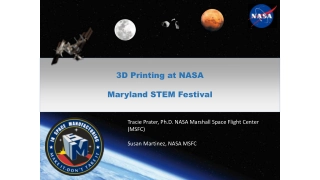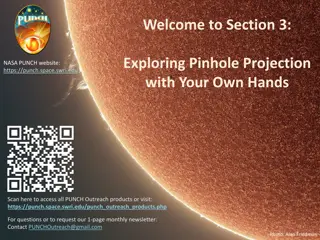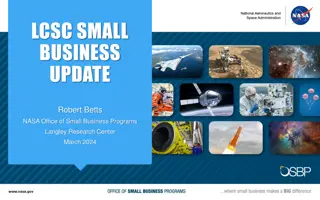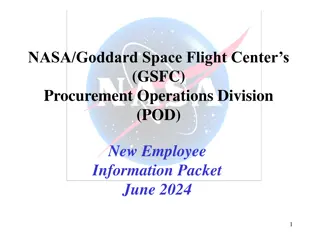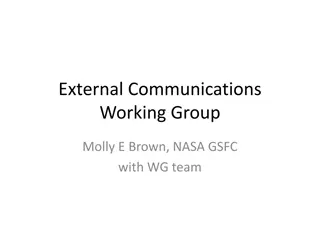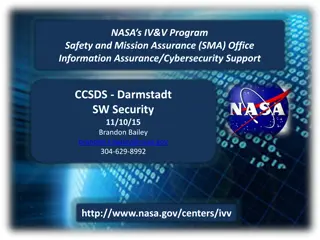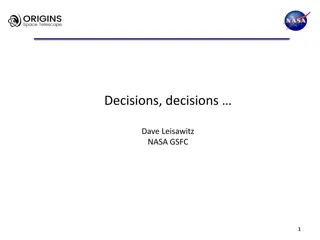Understanding Pinhole Imaging in NASA's PUNCH Mission
Delve into the world of pinhole imaging with NASA's PUNCH mission. Explore how small, lens-less holes create images of the Sun and discover the fascinating process behind pinhole projection. Follow along a playful learning adventure with Bhanu guiding you through sections explaining pinhole imaging techniques. Get hands-on experience with the 3-Hole PUNCH Pinhole Projector and gain insights into observing pinhole images both indoors and outdoors. Embrace confusion as a stepping stone to new insights and understanding. Contact Dr. Cherilynn Morrow for more details.
Download Presentation

Please find below an Image/Link to download the presentation.
The content on the website is provided AS IS for your information and personal use only. It may not be sold, licensed, or shared on other websites without obtaining consent from the author. Download presentation by click this link. If you encounter any issues during the download, it is possible that the publisher has removed the file from their server.
E N D
Presentation Transcript
Welcome to Section 4: Explaining and Understanding How Pinhole Imaging Happens NASA PUNCH website: https://punch.space.swri.edu / Scan here to access all PUNCH Outreach products or visit: https://punch.space.swri.edu/punch_outreach_products.php For questions or to request our 1-page monthly newsletter: Contact PUNCHOutreach@gmail.com 1 Photo: Alan Friedman
[Really] Understanding Pinhole Projection of the Sun Follow along with our playful learning adventure! Outreach for the NASA PUNCH mission And PLEASE give us feedback on these questions at the link below: Insights gained? Remaining questions? Ideas for improvements? https://tinyurl.com/PinholeFeedback MARK 3 Version Final Release for use up to and including the Annular Eclipse on 14 Oct 2023 FRONT BACK 2
Essential viewing: 6-minute how-to-facilitate video [ https://punch.space.swri.edu/punch_outreach_pinholeprojector.php ] Outreach for the NASA PUNCH mission 3
[Really] Understanding Pinhole Projection of the Sun Introducing Bhanu [BAH-noo] Bhanu means ray of light in Sanskrit Outreach for the NASA PUNCH mission Bhanu helps guide our way through these Sections. You are in Section 4 of 5. Section Title of Section Description of Section introduces the 3-Hole PUNCH Pinhole Projector, demonstrates how to use it both outdoors and indoors, and describes its differences from a pinhole camera/viewer. How to Use the 3-Hole PUNCH Pinhole Projector 1 Observing Pinhole Images of the Sun in Our Everyday Environments teaches you how to observe the phenomenon of pinhole images of the Sun in our everyday world, both indoors and outdoors. 2 Exploring Pinhole Projection Using Your Own Hands invites you to explore the behavior of pinhole projection by experimenting with your own hands (try both palms up!) 3 guides your quest for explanations and deeper understanding of how pinhole imaging happens. After this, you will really understand why small, lens-less holes can create images. Explaining and Understanding How Pinhole Imaging Happens 4 APPENDICES A-E: More Insights & Fun Resources offers more insights & resources (e.g., explaining the relationship between pinhole images and the view through eclipse glasses) 5 CONTACT: Dr. Cherilynn Morrow, Outreach Director for the NASA PUNCH mission [cherilynn.morrow@gmail.com] 4
Pinhole Projection of the Sun Outreach for the NASA PUNCH mission 4. Explaining and Understanding How Pinhole Imaging Happens Bahnu says: Find the courage to be confused! Lots of things worthy of our understanding are worth the discomfort of not understanding them at first. Confusion is a sign that you are on the path to a new insight. Persevere! 5 CONTACT: Dr. Cherilynn Morrow, Outreach Director for the NASA PUNCH mission [cherilynn.morrow@gmail.com]
1. Projector close to surface. Triangle, round, and square shapes of light are sharp. 2. Projector farther away from surface. All three shapes of light are round and fuzzier. Smooth flat projection surface Case 2 Case 1 Outreach for the NASA PUNCH mission Were you able to observe bothCase 1 and Case 2? Image of round Sun through square hole Sunlight comes from this direction and passes thru the holes square shape of light KEY QUESTION: Why don t we see round images of the Sun when the projector is held closer to the projection surface (Case 1), but we do see them when we move it farther away (Case 2)? JO is observing in the morning in Dec 6
Pinhole Projection of the Sun From our exploration of how pinhole projection of the Sun behaves we have collected two key questions: Outreach for the NASA PUNCH mission 1. Why don t we see round images of the Sun when the projector is held closer to the projection surface (Case 1), but we do see them when we move it farther away (Case 2)? 2. How can small, non-round holes formed by gaps between leaves, strands of a straw hat, fingers of our hands, and by our pinhole projectors create images of the round Sun? 7
Pinhole Projection of the Sun If you are not familiar with ray tracing, OR if you would like to experience our novel way of preparing learners to understand ray tracing, please continue to the next slide. Outreach for the NASA PUNCH mission If you are already familiar with ray tracing, go to slide 34. 8
Pinhole Projection of the Sun From our exploration of how pinhole projection of the Sun behaves we have collected two key questions: Outreach for the NASA PUNCH mission To address our two questions, we first need to study how light emitted or reflected from an object interacts with the pinhole card to reach a projection surface. Bhanu will help. Because we should not look directly at the Sun, we will pretend that Bhanu is the Sun, and our eye is viewing Bhanu from the perspective of different positions on the projection surface. Sun Bhanu 9
To safely explore how light reflected from Bhanu passes through a pinhole to a projection surface, we view Bhanu through a small, non-round hole. Outreach for the NASA PUNCH mission Bhanu [BAH-noo] Bhanu means ray of light in Sanskrit NEVER look at the Sun through the holes in a pinhole projector! 10
To make your own observations find an object like Bhanu to view that can represent the Sun An object about a foot (~30 cm) tall works well. Your object should have different features at the top and bottom and ideally left and right. Outreach for the NASA PUNCH mission Sun Your object (our Bhanu) Bhanu [BAH-noo] Bhanu means ray of light in Sanskrit Bhanu is ideal for our exploration. The bear has a brown head and blue feet, plus a bow on the left, but not on the right. 11
Then find or create a small hole to use for this activity. If you do not have a 3-Hole PUNCH pinhole projector, then make a card with small hole. Outreach for the NASA PUNCH mission You can use a 3 x 5 card or a section of a cereal box. Cut a small (~5 mm) square hole near the center of it. BACK 12
If you cannot use or make a card with a hole, then you can use a small gap in your fingers Outreach for the NASA PUNCH mission Any shape of small hole works for this activity. 13
Place the object you have selected a few feet away from you. Outreach for the NASA PUNCH mission Bhanu [BAH-noo] For an object about a foot (~30 cm) tall, a distance of 4 to 5 feet (1.2 to 1.5 m) away from you works well. 14
Hold the card next to your eye and look through the hole at your chosen object Make sure you can see ALL of your object. If you cannot see the whole object, then increase the distance between you and the object until you can. Outreach for the NASA PUNCH mission MZ is using the hole in a piece of paper to follow along with this activity. Eye Your object represents the Sun Card with hole Projection surface To learn how sunlight interacts with a pinhole, we view light reflected from your object (Bhanu) as if it were light emitted from the Sun. Your eye receives light as if it were a particular location on a projection surface. 15
Starting with the card close to your eye and seeing the whole object . Move the card a bit farther away from your eye while looking at the object through the hole. Outreach for the NASA PUNCH mission How far do you have to move the card from your eye before you can no longer see the whole object? Notice that the farther away you hold the card, the less of the object you see directly through the hole. 16
How much of the object you can see depends on the distance between your eye and the card with the hole Card with hole is closer to your eye Eye Projection surface Card with hole Card with hole is farther from your eye Eye Projection surface Card with hole 17
What happens if we change the viewpoint of our eye? Card with hole is farther from your eye Eye Projection surface Card with hole Head moved DOWN to look through the hole Card with hole is farther from your eye ?? ?? Eye Card with hole Projection surface 18
To change the viewpoint of your eye through the hole 1. Hold the card steady at a distance where you cannot see the whole object, but only the middle parts. 2. Move your head DOWN just a little bit while still looking at the object through the hole. Outreach for the NASA PUNCH mission Which part of the object can you see? ?? 19
When you move your head DOWN while holding the card steady, you should be able to see the upper parts of the object. Outreach for the NASA PUNCH mission Which part of the object can you see? The top of the object 20
Keeping your card steady, now move your head UP just a bit while still looking at the object through the hole. Outreach for the NASA PUNCH mission Which part of the object can you see? ?? 21
When you move your head UP while holding the card steady, you should be able to see the lower parts of the object. Outreach for the NASA PUNCH mission Which part of the object can you see? The bottom 22
When the card is farther away from your eye and you move your head UP, you can see the lower parts of the object (including Bhanu s feet) through the hole. Card with hole is farther from your eye Eye Card with hole Head moved UP to look through the hole Card with hole is farther from your eye Eye Only light from Bhanu s lower parts can reach the eye Card with hole Projection surface 23
When the card is farther away from your eye and you move your head DOWN, you can see the upper parts of the object (including Bhanu s head) through the hole. Card with hole is farther from your eye Eye Card with hole Head moved DOWN to look through the hole Card with hole is farther from your eye Eye Only light from Bhanu s upper parts can reach the eye Projection surface Card with hole 24
NEVER EVER look at the Sun through the holes! We are using Bhanu (your object) to represent the Sun. Bhanu is helping us to SAFELY learn how sunlight passes through the hole to reach the projection surface. Outreach for the NASA PUNCH mission Your object represents the Sun Smooth flat projection surface JO is holding the 3-Hole PUNCH Pinhole Projector The position of our eye as we look at Bhanu is like a place on this surface. We want to know: Which parts of the projection surface receive light which parts of Bhanu? projection from 25 NEVER EVER look at the Sun through the holes!
Seeing your object (Bhanu) from the different eye positions Every point on your object (Bhanu) reflects light (from sources in the room) in all directions. This is shown at two points: 1) the tan lines from Bhanu s ear and 2) the blue lines from Bhanu s foot. Smooth flat projection surface Card with hole Head raised up Head in middle Head lowered down As you look at Bhanu through the hole from the middle eye viewpoint, your eye receives light only from the middle parts of Bhanu. This part of the projection surface cannot receive any light rays from Bhanu s ear (tan lines) or foot (blue lines) because they are blocked by the card. 26
Seeing your object (Bhanu) from the different eye positions The viewpoint of your eye is like a location on the projection surface. We want to know: Which parts of the projection surface receive light from which parts of Bhanu? Smooth flat projection surface Card with hole Head raised up Head in middle Head lowered down When you looked through the hole at Bhanu from lower and higher viewpoints you could see that: only light from the upper parts of Bhanu would reach the lower parts of the projection surface, and only light from the lower parts of Bhanu would reach the upper parts of the projection surface. 27
Now return to your card with the hole: 1. Hold the card steady at a distance from your eye where you cannot see all of your object (Bhanu), but just the middle parts. 2. Move your head around to change your direction of viewing the object through the hole: up, down, left, right, and so on. Outreach for the NASA PUNCH mission Move head up See Bhanu s feet Move head right Move head left Don t see Bhanu s bow See Bhanu s bow Move head down As you move your head around, notice that you can receive reflected light from all parts of the object, even though you cannot see the whole object from one single perspective. See Bhanu s head 28
Pinhole Projection of the Sun To understand pinhole imaging of the Sun, keep the Bhanu activity in mind. It is important to hold this distinction between seeing the whole object at once from a single perspective (Case 1) and seeing only parts of the object from corresponding opposite perspectives (Case 2). Outreach for the NASA PUNCH mission Case 2 Case 1 29
For safety reasons during the previous activity, your object (our Bhanu) has represented the Sun. To advance our exploration we now turn Bhanu back into the Sun. Outreach for the NASA PUNCH mission In the diagrams on the next three slides, Bhanu becomes the Sun. Sun Bhanu The different viewpoints of your eye while looking at Bhanu through the hole now return to being locations on a smooth flat projection surface that receives the Sun s light through the hole. NEVER look at the Sun through the holes in the card! 30
The distance between the card with the hole and the smooth flat projection surface determines how much of the Sun s disk would be visible to the projection surface from a single viewpoint. Smooth flat projection surface NEVER look at the Sun through the holes in the card! CASE 1 - closer In CASE 1, the projection surface would receive light from all of the Sun s disk from a single viewpoint Case 1 is like holding the card close to your eye and seeing ALL of the object at once Card with hole Smooth flat projection surface CASE 2 - farther In CASE 2, the projection surface would receive light from only part of the Sun s disk from a single viewpoint. Case 2 is like holding the card farther from your eye and seeing PART of the object Card with hole 31
In Case 2, when the card with the hole is farther away from the projection surface, the lower part of the projection surface only receives light from the upper part of the Sun. Smooth flat projection surface NEVER look at the Sun through the holes in the card! Light from the upper part of the Sun would only reach the lower part of the projection surface. Lower part of projection surface Card with hole This is like when you lowered your head to see the top of the object through the hole. Eye Only light from Bhanu s upper parts can reach the eye Head moved DOWN to look through the hole Card with hole 32
In Case 2, when the card with the hole is farther away from the projection surface, the upper part of the projection surface only receives light from the lower part of the Sun. Smooth flat projection surface NEVER look at the Sun through the holes in the card! Upper part of projection surface Light from the lower part of the Sun would only reach the upper part of the projection surface. Card with hole This is like when you raised your head to see the bottom of the object through the hole. Head moved UP to look through the hole Eye Only light from Bhanu s lower parts can reach the eye 33 Card with hole
Pinhole Projection of the Sun PLEASE NOTE The Sun is VERY far away compared to distances between the projection surface and the card-with-the-hole. Thus, it is impossible to make diagrams (such as those on the next slides) with the proper scale. To make the principles of pinhole projection clear we adjust the size of the Sun in the diagrams. This allows us to illustrate how the apparent size of the Sun compares to the size of the hole (as seen from the projection surface). Size of hole Apparent size of Sun relative to the hole When there is a closer distance between the card-with-the-hole and the projection surface, the Sun appears smaller relative to the hole. When there is greater distance between the card-with-the-hole and the projection surface, the apparent size of the Sun is larger relative to the hole. 34
Pinhole Projection of the Sun If the projection surface is close enough to the card-with-the-hole then we get shapes of light and no imaging on the projection surface. [CASE 1] Size of hole Apparent size of Sun relative to the hole This is like seeing the whole Bhanu from a single perspective. If the projection surface is farther from the card-with-the-hole then we begin to get the imaging effect where light from particular parts of the Sun only reaches particular parts of the projection surface. [CASE 2] Size of hole Apparent size of Sun relative to the hole This is like seeing only part of Bhanu from a single perspective. 35
Pinhole Projection of the Sun Now we are ready to address our questions 1. Why don t we see round images of the Sun when the projector is held closer to the projection surface (Case 1), but we do see them when we move it farther away (Case 2)? 2. How can small, non-round holes formed by gaps between leaves, strands of a straw hat, fingers of our hands, and by our pinhole projectors create images of the round Sun? 36
Pinhole Projection of the Sun Why don t we get solar images when the projector is held closer to the surface? CASE 1 Smooth flat projection surface At this closer distance between the card and projection surface, light from every part of the Sun s disk can be received through every part of the hole to the projection surface. Card with hole CASE 1 When the Sun s apparent size is smaller than the square hole, we see a square shape of light on the projection surface Sun Apparent size of Sun relative to the hole Size of hole In CASE 1, light from every part of the Sun can pass through every part of the hole. So, light from any part of the Sun can reach every part of the projection surface that is directly behind the hole. Light from everywhere on the Sun fills the hole, making a shape of light on the projection surface with the same shape as the hole. 37
Pinhole Projection of the Sun How can small, non-round holes create images of the round Sun? CASE 2 At this larger distance between the card and projection surface, only light from part of the Sun s disk can pass directly through the hole to the projection surface. Smooth, flat projection surface Card with hole The Sun s apparent size is larger than the square hole. Sun Size of hole Apparent size of Sun relative to the hole In CASE 2, only light from near the center of the Sun can pass through the hole to the projection surface. Parallel rays coming from the outer parts of the Sun (dashed lines) are blocked by the card. BUT 38
Pinhole Projection of the Sun How can small, non-round holes create images of the round Sun? BUT light rays coming in at an angle from the outer parts of the Sun can pass through the hole to reach the projection surface. Smooth, flat projection surface Card with hole CASE 2 The Sun s apparent size is larger than the square hole. Sun Bhanu was the Sun so we could learn how this works. Light from the upper part of the Sun arrives at the bottom part of the projection surface (red dashed line). And light from the lower part of the Sun arrives at the top part of the projection surface (green dotted line). Recall when we pretended Bhanu was the Sun. You shifted your head up to see the bottom of Bhanu (eye at green arrow tip), and you shifted your head down to see the top of Bhanu (eye at red arrow tip). 39
Pinhole Projection of the Sun How can small, non-round holes create images of the round Sun? CASE 2 Smooth, flat projection surface Only light from the inner part of the Sun s disk can pass directly through the hole to the projection surface. Card with hole CASE 2 We see a circular shape of light on the projection surface Sun IMAGE NOT to SCALE Light from outer parts of the Sun s disk can only reach the projection surface at an angle. The Sun s apparent size is larger than the size of hole Not to Scale Because the Sun s disk is round, sunlight from outer parts of the Sun forms a ring of light that surrounds the central shape of light. In this case, we start to form a fuzzy, inverted image of the round Sun through the square hole (or any other shape of hole with comparable size). 40
Pinhole Projection of the Sun How can small, non-round holes create images of the round Sun? CASE 2 Card with hole We see a circular shape of light on the projection surface Sun IMAGE NOT to SCALE Smooth, flat projection surface We start to see an image of the Sun because there begins to be correspondence between light coming from a particular region of the Sun and light received at a particular (opposite) region of the projection surface (top-to-bottom, left-to-right). This correspondence is key to image formation. The tighter the correspondence, the sharper the inverted image on the projection surface. In Case 1, there is no such correspondence and so no image forms. 41
Pinhole Projection of the Sun How can small, non-round holes create inverted images of the round Sun? CASE 1: No imaging of the Sun. Light from every part of the Sun can pass through every part of each of the holes (square, triangle, and round) to the projection surface. Case 1 See hole-shaped light shapes on projection surface Sun CASE 1 Projector held closer to the smooth, flat projection surface => see hole shapes of light. Smooth flat projection surface Card with hole is closer to surface CASE 2: Start to form images of the Sun. Light from outside the center of the Sun must pass through the holes at an angle. This starts to force a correspondence between places on the Sun and places on the projection surface, which is necessary for images of the Sun to start forming. Case 2 The 3 holes each make a fuzzy round shape of light on the surface Sun CASE 2 Projector held farther from the smooth, flat projection surface => fuzzy, inverted images of the round Sun. Card with hole is farther from surface Smooth flat projection surface 42
Pinhole Projection of the Sun Pinhole Images seen on the projection surface are inverted both top-to-bottom and left-to-right. CASE 2 Card with square hole We see a circular shape of light on the projection surface Sun IMAGE NOT to SCALE Smooth, flat projection surface Q: Why do we see an inverted image when light from an object is projected through a pinhole onto a surface? A: Because light from the Sun passes through the hole and arrives at the opposite side of the projection surface, top-to-bottom AND right-to-left. [Note the little sunspot] 43
Our pinhole projector is based on the same principles as the famous camera obscura effect. The image in the darkened space is inverted both top-to-bottom AND left-to-right. 2. Use the yellow line to find the head of the 1. Use the blue lines to find the top & bottom of the statue in both the real scene and the projected image on the board in the darkened area. Can you also use the yellow line to find the head of the person in both the real scene and the person in both the real scene and the projected image on the board in the darkened area. 3. By noting the position of the seated man in both the real scene and the projected image, can you see that the image is inverted both top-to-bottom AND left-to-right? 44 Also see: https://en.wikipedia.org/wiki/Camera_obscura
How are Pinhole Images of Eclipses Inverted? See Section 5: APPENDIX A Discovering How Pinhole Images of Eclipses are Inverted An indoor demo using the 3-Hole PUNCH Pinhole Projector with an F-shaped light source [Super neat! Don t miss it!] Outreach for the NASA PUNCH mission A 3-slide demo using images from the 2017 solar eclipse A 6-slide interactive inquiry using images from the 2012 Annular Eclipse seen from Pueblo Bonito, Chaco Canyon, NM Pinhole images through gaps at elbows View through solar protection glasses See how these contemporaneous images of the eclipsed Sun are the same but inverted left-to-right and top-to-bottom 45
Why are our Projector Images Fuzzy? Why Aren t They in Focus? Outreach for the NASA PUNCH mission See Section 5: APPENDIX B What Does it Mean to be in Focus? ? 46
THANK YOU! Thank you for your curiosity about pinhole projection! We hope you ve gained some enjoyable insights and will continue to explore! Outreach for the NASA PUNCH mission PLEASE SEE ADDITIONAL INFO On the Next Slides (Section 5) Pinhole Images of the Sun are Everywhere. Keep an eye out every sunny day! 47 Bhanu
ADDITIONAL INFORMATION ADDITIONAL INFORMATION Outreach for the NASA PUNCH mission Link for Feedback Valuable References Credits & Acknowledgements Links to PUNCH & PUNCH Outreach Products 48 CONTACT: Dr. Cherilynn Morrow, Outreach Director for the NASA PUNCH mission [cherilynn.morrow@gmail.com]
[Really] Understanding Pinhole Projection of the Sun Follow along with our playful learning adventure! Outreach for the NASA PUNCH mission And PLEASE give us feedback on these questions at the link below: Insights gained? Remaining questions? Ideas for improvements? https://tinyurl.com/PinholeFeedback MARK 3 Version Final Release for use up to and including the Annular Eclipse on 14 Oct 2023 FRONT BACK 49
Valuable References 1. Lenses and Pinholes: What Does In Focus Mean? A brief and clear explanation about what it means to be in focus : https://www.physicsforums.com/insights/lenses-pinholes-focus-mean/ 2. How a Pinhole Camera Works (Part 1) Excellent diagrams: https://www.scratchapixel.com/lessons/3d-basic-rendering/3d-viewing-pinhole-camera 3. Real image: Collection of focus points made by converging light rays We love the simple but insightful stick-figure: https://www.wikiwand.com/en/Real_image 4. Your Eyes See Upside Down and Reversed Lucid explanation by an eye doctor (MD) relating human eye to a pinhole camera: https://bceye.com/retinal-image-inverted-reversed/ 5. Camera Obscura The history of this wondrous effect, including reference to a possible paleo-camera: https://en.wikipedia.org/wiki/Camera_obscura http://paleo-camera.com/archeo-optics/ 6. Making, Measuring and Testing the Optimal Pinhole A thorough and playful journey through the technical details of pinhole photography: https://www.35mmc.com/26/10/2020/making-measuring-and-testing-the-optimal-pinhole-pinhole- adventures-part-3-by-sroyon/ 50


